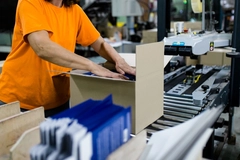Cepi harmonizes European paper recycling standards ahead of mandatory EU targets
12 Oct 2022 --- The Confederation of European Paper Industries (Cepi) is updating its harmonized recyclability test method, developed with partners from the entire paper value chain, including specialized testing laboratories.
The method is particularly relevant to the paper packaging industry. Cepi highlights that many paper packaging solutions already enjoy high recycling rates, but are also increasingly fulfilling new functionalities. These need to be considered by brand owners aiming to reach ever higher performance in terms of circularity and sustainability for their products.
“Cepi has initiated the work on a harmonized European recyclability test method by bringing together the paper institutes and technical associations from the biggest four European markets and converge existing methods into one method,” Ulrich Leberle, raw materials director at Cepi tells PackagingInsights.
Design guidelines and evaluation protocols are developed to support value chain actors to make all paper packaging recyclable by 2025 and reach a recycling rate of 90% by 2030.
Cepi says its updated harmonized recyclability test method offers a “solid basis” for reaching these goals and allows paper products across Europe to be tested for their recyclability in identical conditions.
 Ulrich Leberle, raw materials director at Cepi.Testing method
Ulrich Leberle, raw materials director at Cepi.Testing method
The testing method emulates the processes at the industrial scale in paper recycling mills, while in laboratory conditions. Its new annexes were developed through intensive work provided by companies involved in 4evergreen. The workstream established a “reality check” of the current method and informed the efforts of testing institutes.
4evergreen is an alliance bringing together the entire fiber-based packaging value chain, including a number of global blue-chip companies.
Leberle explains the test method mimics the essential steps of a standard paper recycling mill: “disintegration, coarse screening, fine screening, production of a sheet that can be analyzed. In the laboratory, the sample needs to be specified and prepared before submitting it to those steps.”
“With the analysis of the material after these different steps, it is possible to determine the quantity of coarse reject and the quality of the recyclate. These are relevant parameters that can further be used to evaluate the recyclability of a paper product.”
Necessary partnerships
The support of 4evergreen members over a nine month period was essential to the project’s success. The company asserts they carried out a plethora of tests that informed what improvements should be made to the method and the development of three technical annexes.
The alliance will soon release a “recyclability evaluation protocol,” which will provide packaging developers with “pass through” criteria based on the updated recyclability testing method. This will further support the industry in producing fiber-based packaging compatible with a low-carbon, climate-neutral society. It is crucial that recyclability evaluations take place on the basis of a harmonized test method, says Leberle.
It is crucial that recyclability evaluations take place on the basis of a harmonized test method, says Leberle.
“It is crucial that recyclability evaluations take place on the basis of a harmonized test method. Otherwise it is very difficult to compare the recyclability of different paper products with precision. The Cepi harmonized recyclability test method provides this basis now, ” says Leberle.
Earlier this year, the European Parliament’s Environment, Public Health and Food Safety Committee voted on a series of key pieces of the package proposed last year by the European Commission (EC).
Cepi said the outcome of the votes offers a few positive signs to the pulp and paper industry, as members acknowledged some of the contributions of the broader forest sector to climate action.
In other news, Cepi has called for national governments in the EU to mitigate the mounting pressure gas shortages are putting on industry as Russian supplies continue to run short.
In a recent announcement, Cepi demanded Member States make full use of provisions given to them by the EC following its release of the Winter Preparedness Package, which outlined the intertwined needs of European citizens and industry in the face of deteriorating energy supplies.
By Natalie Schwertheim












